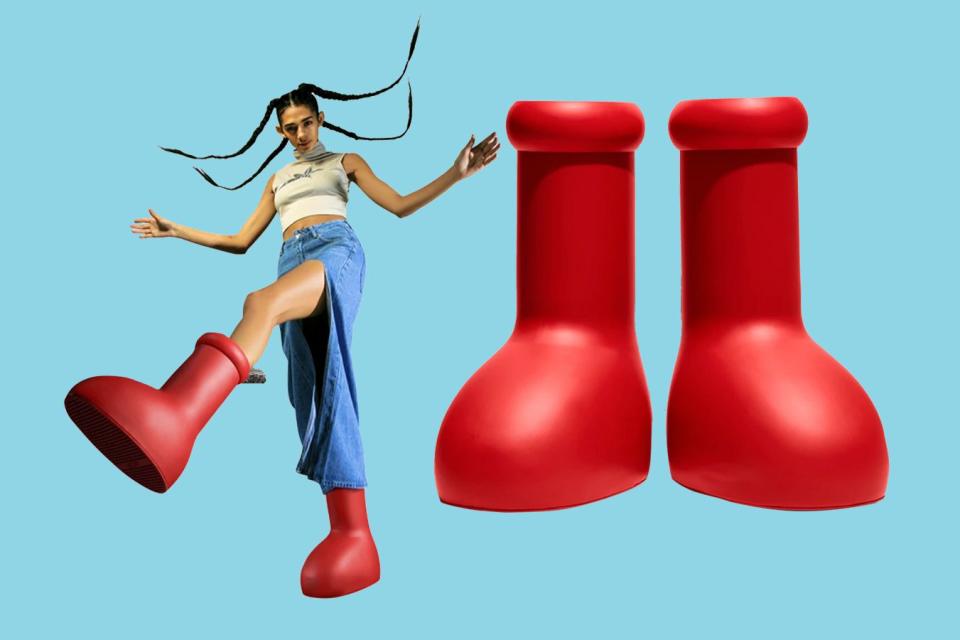Um, Why Is Everyone Wearing These Big Red Boots Right Now?
Are we all…just living in a simulation?

MSCHF
They’re big, they’re red, and they’re everywhere. Ever since MSCHF’s Big Red Boots were leaked online on February 6, they have taken the internet by storm, with countless celebrities sporting the cartoonish kicks and even more meme pages clowning them.
MSCHF, the Brooklyn art collective that birthed the boots, calls them “cartoon boots for a 3D world.” According to the product description, “Cartoonishness is an abstraction that frees us from the constraints of reality. If you kick someone in these boots they go boing!”
It’s an interesting and completely ridiculous concept (who among us hasn’t wanted someone to go boing?). These boots are supposed to make you feel like a superhero. Images on the MSCHF site show models with an artificial sheen wearing the boots among crumbling buildings, flying, running, bending over backwards, and riding motorcycles.
If you take a look at the many celebrities wearing the boots, it seems possible that they do provide superpowers. Oklahoma City Thunder Player Shai Gilgeous-Alexander was one of the first celebrities to step out in the boots before his game against the Lakers. OKC won the game, and Gilgeous-Alexander contributed an impressive 30 points and eight assists. Janelle Monae posted a video of her wearing the boots while making jump shots in preparation for the Celebrity All Star Game. Coi Leray went viral after wearing the boots during a dazzling halftime performance at a Brooklyn Nets game.
Superpowers aside, it's impressive that people can even walk in these oversized boots (they’re not exactly practical), let alone accomplish physical feats. Oh, and did we mention it’s $350?
According to MSCHF, the continued blending of virtual and real life aesthetics has us chasing supernormal stimuli, and the boots are a product of that chase. As the Metaverse and artificial intelligence grow more and more realistic, why can’t reality grow more and more artificial?
The Big Red Boots are certainly unique, but they are far from the first example of fashion blending the real and the fake. The foundation for this trend has been slowly building for years as AI evolved to its current, frightening realness. But the escapism at the root of today’s iterations really started to take hold during the COVID-19 lockdown, when we were all holed up in our homes with nothing but the artificial to entertain us.
Fashion shows moved online, giving forward-thinking designers the opportunity to play with the intersection of fantasy and reality. Take designer Anifa Myuemba, founder of Hanifa, for example, who streamed a 3D collection of her designs on invisible models, creating a viral sensation. Moschino’s Jeremy Scott presented a micro-sized version of his collection on marionette dolls. Collina Strada Designer Hillary Taymour produced a video for her collection that featured models of various ages and sizes (a fantasy itself in the fashion industry) moving like Sims against a psychedelic backdrop reminiscent of a video game. The brand recently made headlines again by taking the idea of fantasy even further in its Fall 2023 show, where models were transformed into unreal creatures using animal-like prosthetics.
With most consumers’ only use for clothes being to sit alone in their homes during the worst of the pandemic, they had more of an opportunity than ever before to play dress-up, embracing the fun, playful side of fashion and trying out looks they never would have when going into the office or to PTA meetings. After all, it’s hard to imagine a pandemic-free world in which Hillhouse nap dresses and high-heeled Crocs became popular.
TikTok user @thealgorythm titles these as “the fashions of hyperreality.” “If fashion has become really good at representing reality rather than implicating it like a cartoon, why can’t we bring implications of reality to life?” she asks.
MSCHF made a similar statement about the boots, saying, “Unreality achieves what cartoons have known for decades: Abstracted forms convey their core idea with an immediacy that a fully realized form cannot.”
This cartoonification of fashion also aligns with puffification—the prevalence of clothing and accessories that are, well, puffy. Prada, for example, has rendered its newest loafers and handbags in thick nappa leather, giving them the appearance of being inflated. The puffy products have since gone viral, stirring commentary that asks if the inflated accessories are indicative of the inflated economy. Other luxury brands like LOEWE and Coach have put out similarly puffy items. Sam Smith even sported the trend at the BRIT Awards, where he wore Harri’s viral inflatable pants with an equally inflated top. A more mainstream version of puffification can be seen with the resurgence of puffer coats.
So, what does it all mean? How will the trend of surreal fashion continue to evolve? Will brands refuse to stop until we’ve all been transformed into giant cartoon characters? Are we all just living in a simulation, as Elon Musk has suggested? Or did MSCHF just attain another five minutes of fame thanks to an aggressive influencer marketing campaign?
I guess we’ll just have to wait and see—anything is possible during the AI revolution. In the meantime, you can snag the boots that just became shoppable on February 16 for $350. Naturally, they’re all sold out at the moment, so you’ll have to wait in line with your boring regular boots until then.
For more Real Simple news, make sure to sign up for our newsletter!
Read the original article on Real Simple.

